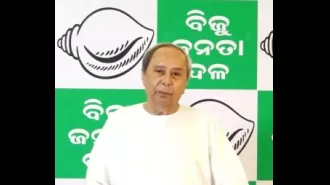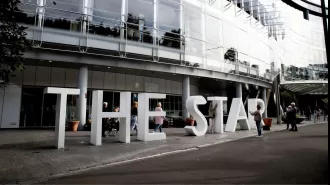Harris and Trump are both desperately trying to win over undecided voters in a final push before the election.
Harris and Trump are using virtual methods to target remaining undecided voters, based on extensive research.
October 22nd 2024.

In the final stretch of the presidential race, Vice President Kamala Harris and former President Donald Trump are on a mission to win over the remaining undecided voters. With months of careful research under their belts, they are determined to reach these elusive Americans and secure their vote.
Inside Harris' campaign headquarters in Delaware, a team of analysts has spent the last 18 months compiling a detailed list of the television shows and podcasts that voters in key battleground states consume. They have also assigned each individual a "contactability score" to determine how difficult they will be to reach and who would be the most effective in delivering Harris' closing message.
These findings have not only shaped Harris' media and travel schedule, but also influenced the appearances of high-profile supporters such as Julia Roberts and Magic Johnson, who have been deployed to swing states based on their appeal to certain voters.
Meanwhile, Trump's team in south Florida has also been hard at work, recently updating their model of the battleground electorate. They have found that only 5% of voters are still undecided, half the number from August. These undecided voters, known as the "target persuadables," tend to be younger, more racially diverse, and have lower incomes. As a result, Trump has been making appearances on popular streaming services and social media platforms, including podcasts aimed at young men.
The urgency to win over these remaining voters is driven by the fact that the presidential race is one of the closest in modern polling history. With the two candidates nearly tied in the battleground states, the election may come down to the undecided Americans who have largely disconnected from political news.
According to senior advisers from both campaigns, the group of undecided voters is predominantly younger and more diverse, with a significant number of Black and Latino voters. Harris' team believes they can also win over some white, college-educated voters, particularly women who have traditionally voted Republican but are turned off by Trump's policies.
A recent analysis by The New York Times and Siena College found that only 3.7% of voters in the battleground states, or about 1.2 million people, are truly undecided. This closely aligns with the campaigns' own findings and underscores the importance of winning over this group in the final weeks.
But persuading these voters to come out and vote is not an easy task. Many, like 22-year-old Kyler Irvins from Arizona, are unsure if voting is even worth their time. Irvins, who has never voted before, says he registered at his mother's insistence but does not follow political news and does not believe his vote will make a difference.
Despite this, both campaigns and their allies are pouring hundreds of millions of dollars into convincing people like Irvins to vote and choose their candidate. Even though Irvins may not actively seek out a ballot, he says he will still vote for Harris if a mail-in ballot comes to his doorstep.
For Harris, the key to winning over these undecided voters lies in a surgical strategy. The campaign believes that up to 10% of voters in the battleground states can still be swayed, including a significant number of Republican women who dislike Trump's policies but want to hear Harris' message on the economy and the border.
This strategy has informed Harris' recent campaign speeches, where she has made a direct appeal to Republicans, particularly those who are put off by Trump. She has also made appearances with prominent Republicans, such as Liz Cheney, in an effort to show her intention to be a president for all Americans, regardless of political party.
In the last week, Harris has also been on a media blitz, appearing on a wide range of shows and platforms, from "60 Minutes" to Howard Stern's radio show. This aggressive approach is aimed at reaching voters across the entire spectrum and breaking through the 0 to 100 "contactability" scale, especially as early voting begins in many states.
While Trump's refusal to participate in a second debate may have limited his opportunities to reach these undecided voters, both campaigns are leaving no stone unturned in their pursuit of this crucial group. With the election riding on the decisions of just a small percentage of voters, every effort is being made to secure their vote and ultimately, the presidency.
The race for the White House is heating up as Vice President Kamala Harris and former President Donald Trump are fiercely competing for the remaining undecided voters. Both sides have been meticulously gathering information about these elusive individuals for the past 18 months, determined to reach them with their closing messages.
At Harris' headquarters in Delaware, analysts have been busy curating a list of the TV shows and podcasts that voters in battleground states are consuming. They have even gone as far as assigning each voter a "contactability score" on a scale of 0 to 100, to determine how difficult it will be to reach them and who would be the most effective messenger for Harris' campaign.
This extensive research has not only influenced Harris' media and travel schedule, but also the deployment of high-profile supporters like Julia Roberts and Magic Johnson to swing states. Similarly, Trump's team in south Florida has been keeping a close eye on the remaining undecided voters, finding that only 5% of them are still up for grabs.
These "target persuadables" are mostly younger, more diverse, and have lower incomes compared to the rest of the electorate. They tend to consume media through streaming services and social media, which explains why Trump has been making multiple appearances on these platforms, including podcasts aimed at young men.
With the presidential race being as close as it is, both campaigns are placing a great emphasis on winning over these undecided voters, who have been largely disconnected from political news. This has proven to be a challenging task, with only 3.7% of voters in battleground states, or roughly 1.2 million people, still undecided.
According to the campaigns, this group consists of a larger number of younger voters, people of color, and those without college degrees. Harris' team is particularly targeting Black voters, who make up about 21% of the undecided group.
One of the main challenges in reaching these undecided voters is that many of them are unsure if voting is even worth their time. Kyler Irvins, a 22-year-old telehealth specialist from Arizona, has never voted before and only registered at his mother's insistence. He did not watch the debates and does not follow the news, but he does remember the pride he felt when Barack Obama won the election in 2008.
Despite the challenges, both campaigns and their allies are pouring millions of dollars into persuading people like Irvins to vote for their candidate. Even though he may not actively seek out a ballot, Irvins admits that he would vote for Harris if a mail-in ballot came to his door.
Harris' campaign has a surgical strategy in place to target these swing voters, aiming for up to 10% of the voters in battleground states. This is slightly higher than what the Trump campaign believes is up for grabs, and aligns with the findings of a recent analysis by The New York Times and Siena College.
One of the key groups that Harris' campaign is targeting is Republican women who may dislike Trump, particularly on issues like abortion, but are open to hearing her message on the economy and the border. Harris has been making a direct appeal to these voters in her campaign speeches, and has even appeared with prominent Republicans like Liz Cheney on the campaign trail.
Harris' recent media blitz, which included interviews on a variety of platforms like "60 Minutes," "The View," and Howard Stern's radio show, was a strategic move to reach voters across her "contactability" scale, especially in light of Trump's refusal to participate in a second debate.
As the election draws near, both campaigns are leaving no stone unturned in their efforts to win over these undecided voters and secure their spot in the White House. The fate of the nation may just rest in the hands of these few elusive individuals who have yet to make up their minds.
Inside Harris' campaign headquarters in Delaware, a team of analysts has spent the last 18 months compiling a detailed list of the television shows and podcasts that voters in key battleground states consume. They have also assigned each individual a "contactability score" to determine how difficult they will be to reach and who would be the most effective in delivering Harris' closing message.
These findings have not only shaped Harris' media and travel schedule, but also influenced the appearances of high-profile supporters such as Julia Roberts and Magic Johnson, who have been deployed to swing states based on their appeal to certain voters.
Meanwhile, Trump's team in south Florida has also been hard at work, recently updating their model of the battleground electorate. They have found that only 5% of voters are still undecided, half the number from August. These undecided voters, known as the "target persuadables," tend to be younger, more racially diverse, and have lower incomes. As a result, Trump has been making appearances on popular streaming services and social media platforms, including podcasts aimed at young men.
The urgency to win over these remaining voters is driven by the fact that the presidential race is one of the closest in modern polling history. With the two candidates nearly tied in the battleground states, the election may come down to the undecided Americans who have largely disconnected from political news.
According to senior advisers from both campaigns, the group of undecided voters is predominantly younger and more diverse, with a significant number of Black and Latino voters. Harris' team believes they can also win over some white, college-educated voters, particularly women who have traditionally voted Republican but are turned off by Trump's policies.
A recent analysis by The New York Times and Siena College found that only 3.7% of voters in the battleground states, or about 1.2 million people, are truly undecided. This closely aligns with the campaigns' own findings and underscores the importance of winning over this group in the final weeks.
But persuading these voters to come out and vote is not an easy task. Many, like 22-year-old Kyler Irvins from Arizona, are unsure if voting is even worth their time. Irvins, who has never voted before, says he registered at his mother's insistence but does not follow political news and does not believe his vote will make a difference.
Despite this, both campaigns and their allies are pouring hundreds of millions of dollars into convincing people like Irvins to vote and choose their candidate. Even though Irvins may not actively seek out a ballot, he says he will still vote for Harris if a mail-in ballot comes to his doorstep.
For Harris, the key to winning over these undecided voters lies in a surgical strategy. The campaign believes that up to 10% of voters in the battleground states can still be swayed, including a significant number of Republican women who dislike Trump's policies but want to hear Harris' message on the economy and the border.
This strategy has informed Harris' recent campaign speeches, where she has made a direct appeal to Republicans, particularly those who are put off by Trump. She has also made appearances with prominent Republicans, such as Liz Cheney, in an effort to show her intention to be a president for all Americans, regardless of political party.
In the last week, Harris has also been on a media blitz, appearing on a wide range of shows and platforms, from "60 Minutes" to Howard Stern's radio show. This aggressive approach is aimed at reaching voters across the entire spectrum and breaking through the 0 to 100 "contactability" scale, especially as early voting begins in many states.
While Trump's refusal to participate in a second debate may have limited his opportunities to reach these undecided voters, both campaigns are leaving no stone unturned in their pursuit of this crucial group. With the election riding on the decisions of just a small percentage of voters, every effort is being made to secure their vote and ultimately, the presidency.
The race for the White House is heating up as Vice President Kamala Harris and former President Donald Trump are fiercely competing for the remaining undecided voters. Both sides have been meticulously gathering information about these elusive individuals for the past 18 months, determined to reach them with their closing messages.
At Harris' headquarters in Delaware, analysts have been busy curating a list of the TV shows and podcasts that voters in battleground states are consuming. They have even gone as far as assigning each voter a "contactability score" on a scale of 0 to 100, to determine how difficult it will be to reach them and who would be the most effective messenger for Harris' campaign.
This extensive research has not only influenced Harris' media and travel schedule, but also the deployment of high-profile supporters like Julia Roberts and Magic Johnson to swing states. Similarly, Trump's team in south Florida has been keeping a close eye on the remaining undecided voters, finding that only 5% of them are still up for grabs.
These "target persuadables" are mostly younger, more diverse, and have lower incomes compared to the rest of the electorate. They tend to consume media through streaming services and social media, which explains why Trump has been making multiple appearances on these platforms, including podcasts aimed at young men.
With the presidential race being as close as it is, both campaigns are placing a great emphasis on winning over these undecided voters, who have been largely disconnected from political news. This has proven to be a challenging task, with only 3.7% of voters in battleground states, or roughly 1.2 million people, still undecided.
According to the campaigns, this group consists of a larger number of younger voters, people of color, and those without college degrees. Harris' team is particularly targeting Black voters, who make up about 21% of the undecided group.
One of the main challenges in reaching these undecided voters is that many of them are unsure if voting is even worth their time. Kyler Irvins, a 22-year-old telehealth specialist from Arizona, has never voted before and only registered at his mother's insistence. He did not watch the debates and does not follow the news, but he does remember the pride he felt when Barack Obama won the election in 2008.
Despite the challenges, both campaigns and their allies are pouring millions of dollars into persuading people like Irvins to vote for their candidate. Even though he may not actively seek out a ballot, Irvins admits that he would vote for Harris if a mail-in ballot came to his door.
Harris' campaign has a surgical strategy in place to target these swing voters, aiming for up to 10% of the voters in battleground states. This is slightly higher than what the Trump campaign believes is up for grabs, and aligns with the findings of a recent analysis by The New York Times and Siena College.
One of the key groups that Harris' campaign is targeting is Republican women who may dislike Trump, particularly on issues like abortion, but are open to hearing her message on the economy and the border. Harris has been making a direct appeal to these voters in her campaign speeches, and has even appeared with prominent Republicans like Liz Cheney on the campaign trail.
Harris' recent media blitz, which included interviews on a variety of platforms like "60 Minutes," "The View," and Howard Stern's radio show, was a strategic move to reach voters across her "contactability" scale, especially in light of Trump's refusal to participate in a second debate.
As the election draws near, both campaigns are leaving no stone unturned in their efforts to win over these undecided voters and secure their spot in the White House. The fate of the nation may just rest in the hands of these few elusive individuals who have yet to make up their minds.
[This article has been trending online recently and has been generated with AI. Your feed is customized.]
[Generative AI is experimental.]
0
0
Submit Comment





